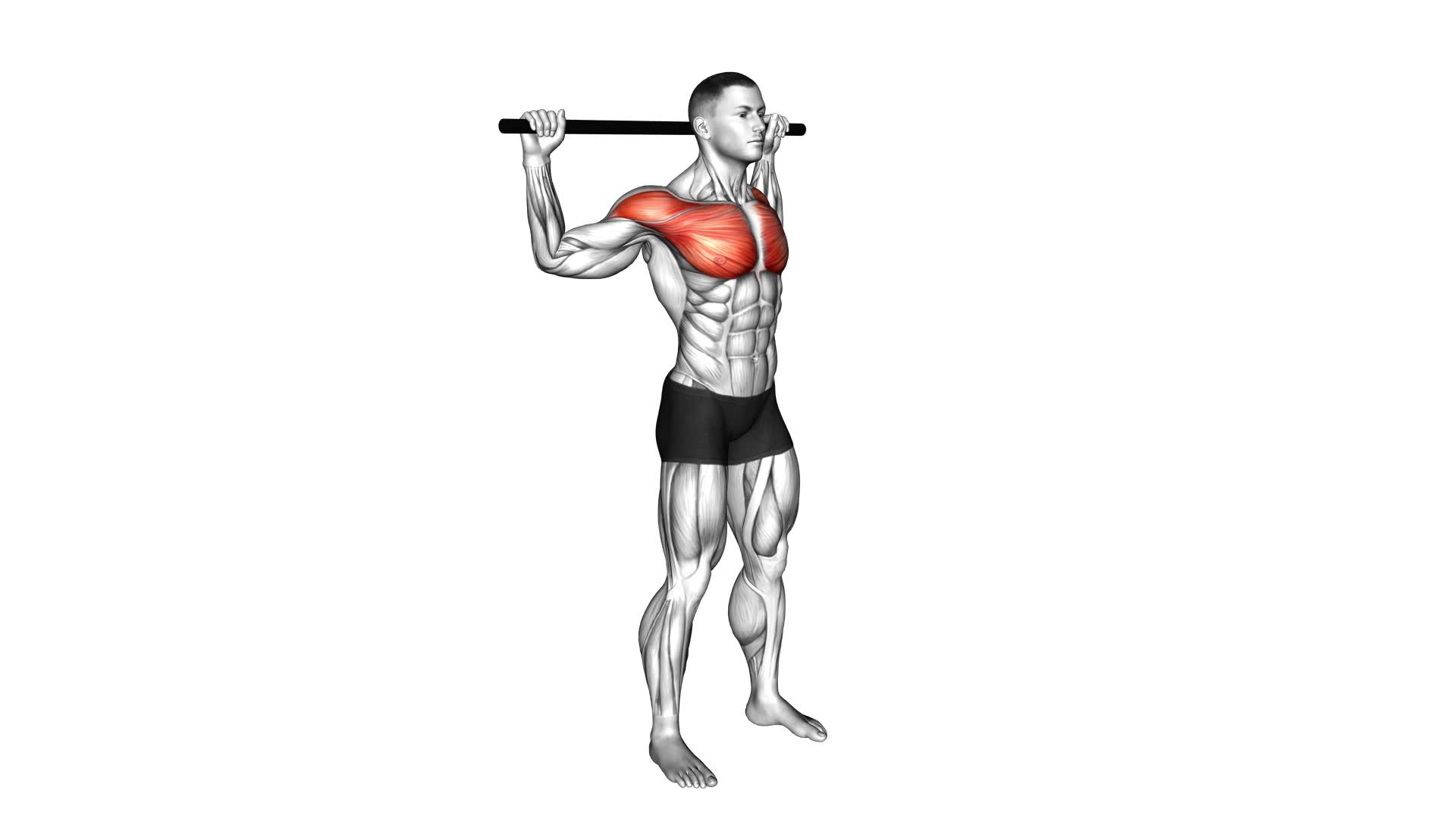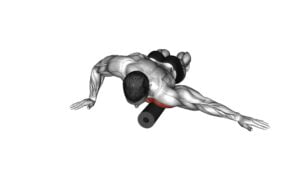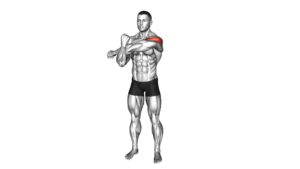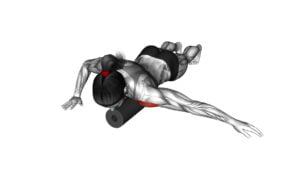Chest and Front of Shoulder Stretch – Video Exercise Guide & Tips

Are you looking for a stretch that targets your chest and front of shoulder? Look no further! This video exercise guide will show you the proper form and technique for the stretch, along with modifications for different fitness levels.
Watch This Exercise Video
Avoid common mistakes and get tips on how to incorporate this stretch into your workout routine. Get ready to improve your flexibility and relieve tension with this chest and front of shoulder stretch.
Let's get started!
Key Takeaways
- The chest and front of shoulder stretch improves posture and increases flexibility in the upper body.
- It targets the chest muscles and front of the shoulders, counteracting the effects of sitting or slouching.
- The stretch can help reduce the likelihood of rounded shoulders or a hunched back.
- It can also enhance the range of motion in the shoulders, arms, and upper back, improving performance in various physical activities.
Benefits of Chest and Front of Shoulder Stretch
To reap the benefits of the Chest and Front of Shoulder Stretch, you can improve your posture and increase flexibility in your upper body. This stretch primarily targets the chest muscles and the front of the shoulders, helping to counterbalance the effects of sitting or slouching for long periods.
By incorporating the Chest and Front of Shoulder Stretch into your routine, you can achieve improved posture. When done regularly, this stretch helps to open up the chest, lengthen the front of the shoulders, and release tension in the upper body. This, in turn, allows you to stand taller and straighter, reducing the likelihood of developing rounded shoulders or a hunched back.
Additionally, this stretch can lead to increased range of motion in the upper body. By actively stretching the chest muscles and front shoulder muscles, you can enhance their flexibility and mobility. This can be particularly beneficial for activities that require reaching or lifting, as it allows for a greater range of motion in the shoulders, arms, and upper back.
To fully experience these benefits, it's important to perform the Chest and Front of Shoulder Stretch with proper form and technique. Maintaining correct alignment and engaging the appropriate muscles will ensure that you maximize the stretch and minimize the risk of injury.
Proper Form and Technique for the Stretch
Now let's delve into how to properly perform the Chest and Front of Shoulder Stretch to ensure you get the most out of this exercise. Here are some important tips to keep in mind:
- Stand tall with your feet shoulder-width apart and your spine straight.
- Interlace your fingers behind your back, palms facing inwards.
- Gently squeeze your shoulder blades together as you lift your hands away from your lower back.
- Keep your chest lifted and your shoulders relaxed.
- Hold the stretch for 20-30 seconds, focusing on deep breathing.
- Be mindful not to strain or overstretch your muscles.
Remember, this stretch is essential for improving chest and front of shoulder flexibility. Stretching before and after workouts is crucial for preventing injuries and enhancing performance. By incorporating this stretch into your routine, you won't only improve your posture but also relieve tension in your chest and shoulders.
With a proper understanding of the form and technique, you can now perform the Chest and Front of Shoulder Stretch effectively.
In the next section, we'll explore modifications and variations for different fitness levels, allowing you to tailor the exercise to your specific needs and goals.
Modifications and Variations for Different Fitness Levels
As you progress in your fitness journey, you can modify and vary the Chest and Front of Shoulder Stretch to suit your specific fitness level. There are several modifications and variations that you can incorporate into this stretch to challenge yourself or make it easier, depending on your needs.
For individuals looking for a more intense stretch, you can try using a foam roller or a yoga block to elevate your chest and shoulders. This will increase the stretch on your chest and front of shoulders, providing a deeper release. Additionally, you can experiment with different hand positions, such as interlacing your fingers behind your back or placing your hands on a wall, to target different areas of the chest and shoulders.
On the other hand, if you find the stretch too challenging, you can make modifications to make it more accessible. For instance, you can perform the stretch while seated on a chair, which will provide more support and stability. You can also try reducing the range of motion by bringing your hands closer together or lowering them slightly.
Common Mistakes to Avoid During the Stretch
To maximize the effectiveness of the Chest and Front of Shoulder Stretch and prevent potential injuries, it's important to be aware of common mistakes that should be avoided during the exercise. Proper technique is crucial to ensure that you're getting the most out of this stretch and avoiding any unnecessary strain on your muscles. Here are some common mistakes to watch out for:
- Rounding the shoulders: One of the most common mistakes is allowing the shoulders to round forward during the stretch. This not only reduces the effectiveness of the stretch but can also lead to poor posture and shoulder pain over time.
- Overarching the back: Another mistake to avoid is over-arching the back during the stretch. This can put excessive strain on the lower back and limit the range of motion in the shoulders.
- Holding the breath: Many people tend to hold their breath while stretching, which can cause tension and restrict the stretch. Remember to breathe deeply and continuously throughout the exercise to maximize its benefits.
Tips for Incorporating the Stretch Into Your Workout Routine
To optimize your workout routine, consider incorporating the Chest and Front of Shoulder Stretch for improved flexibility and reduced muscle tension. This stretch is particularly beneficial as part of your workout warm-up and flexibility training.
Before you begin your workout, take a few minutes to perform this stretch. Start by standing tall with your feet shoulder-width apart. Extend your arms straight out to the sides, parallel to the floor. Then, slowly bring your arms forward, crossing them in front of your body. Place your right arm over your left arm and interlace your fingers, if possible.
Next, gently squeeze your shoulder blades together as you push your hands away from your body, feeling a stretch in your chest and the front of your shoulders. Hold this position for 20 to 30 seconds while maintaining a relaxed breathing pattern.
When incorporating this stretch into your workout routine, remember to perform it on both sides of your body to ensure balanced flexibility. You can also modify the stretch by adjusting the height of your hands or the angle of your arms to target different areas.
Frequently Asked Questions
Can the Chest and Front of Shoulder Stretch Help Improve Posture?
Yes, the chest and front of shoulder stretch can definitely help improve your posture.
By stretching these muscles, you can release tension and tightness in the chest and shoulders, allowing for better alignment of the spine and shoulders.
This can help counteract the forward head and rounded shoulder posture that many people develop from sitting for long periods or hunching over electronic devices.
Is It Safe to Perform the Stretch if I Have a Shoulder Injury?
If you have a shoulder injury, it's important to be cautious when performing the chest and front of shoulder stretch.
Consult with a healthcare professional specializing in shoulder rehabilitation to determine if it's safe for you.
There may be alternative shoulder stretches that are more suitable for your condition.
Always prioritize your safety and follow expert advice to prevent further injury and promote proper healing.
How Long Should I Hold the Stretch for Maximum Benefit?
To get the maximum benefit from the stretch, it's important to hold it for the right amount of time. Stretch duration varies depending on the specific stretching technique you're using. Different techniques recommend different durations, ranging from 15 to 60 seconds.
The key is to hold the stretch long enough to feel a gentle pull in the chest and front of the shoulder, but not so long that it becomes uncomfortable or painful.
Can This Stretch Help Relieve Tension in the Neck and Upper Back?
Yes, this stretch can help relieve tension in the neck and upper back. By stretching the chest and front of the shoulders, you're also stretching the muscles that connect to the neck and upper back. This can help alleviate neck and shoulder pain and improve overall flexibility.
Regular stretching can have many benefits, including reducing muscle tightness, increasing range of motion, and improving posture.
Are There Any Specific Warm-Up Exercises Recommended Before Performing the Chest and Front of Shoulder Stretch?
Before performing the chest and front of shoulder stretch, it's important to do a pre-stretch warm-up. This will help prepare your muscles and prevent injury.
You can try alternative stretches like arm circles and shoulder rolls to warm up the chest and shoulder area. These exercises will help increase blood flow and flexibility, making the chest and front of shoulder stretch more effective.
Remember to listen to your body and stop if you feel any pain or discomfort.
Conclusion
Incorporating the chest and front of shoulder stretch into your workout routine can provide numerous benefits, such as increased flexibility and improved posture. By following proper form and technique, you can effectively target these muscle groups and prevent common mistakes.
Whether you're a beginner or an advanced fitness enthusiast, there are modifications and variations available to suit your fitness level.
Don't forget to stretch regularly to maintain a balanced and healthy body.

Author
Years ago, the spark of my life’s passion ignited in my mind the moment I stepped into the local gym for the first time. The inaugural bead of perspiration, the initial endeavor, the very first surge of endorphins, and a sense of pride that washed over me post-workout marked the beginning of my deep-seated interest in strength sports, fitness, and sports nutrition. This very curiosity blossomed rapidly into a profound fascination, propelling me to earn a Master’s degree in Physical Education from the Academy of Physical Education in Krakow, followed by a Sports Manager diploma from the Jagiellonian University. My journey of growth led me to gain more specialized qualifications, such as being a certified personal trainer with a focus on sports dietetics, a lifeguard, and an instructor for wellness and corrective gymnastics. Theoretical knowledge paired seamlessly with practical experience, reinforcing my belief that the transformation of individuals under my guidance was also a reflection of my personal growth. This belief holds true even today. Each day, I strive to push the boundaries and explore new realms. These realms gently elevate me to greater heights. The unique combination of passion for my field and the continuous quest for growth fuels my drive to break new ground.







